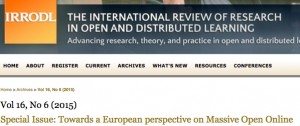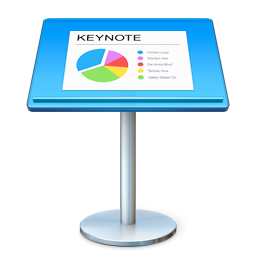We certainly are past the famed “Year of the Mooc” but there availability and I will argue impact on adult education is far from past. This week’s special issue edited by Markus Deimann, Sebastian Vogt adds many new insights – a few of which I’ll comment on in this post.
The first article MOOCs and the Claim of Education for All: A Disillusion by Empirical Data by German authors Matthias Rohs and Mario Ganz works within a critical paradigm to address issues of inequality and lack of opportunity to debunk the notion that MOOCs are “education for all.” The article is well written and has some good conceptual information on Knowledge Gap Theory, but I didn’t find their survey results either original or surprising. I don’t think that finding that most people in Germany who take MOOCs on Adult Education are themselves adult educators and already have University degrees is at all surprising, nor a valid criticism of MOOCs. The notion that MOOCs attract niche audiences is not surprising nor alarming. They also lament the increase in 2-tier MOOCs whereby students wishing to get a certificate and be tested in their learning, are required to pay a fee. However, I think to be viable a MOOC needs some revenue stream and this model still allows the learner to browse or consume with no cost.
The 2nd article Opportunities and Threats of the MOOC Movement for Higher Education: The European Perspective, by a host of well-known European authors provides an EU centric look at the opportunities and threats of MOOCs. The study uses a twitter hash tag data-collection technique which provides a unique way to do a type of Delphi study, but the participation rate and number of tweets is surprisingly low. No surprises are the opportunities for innovation and collaboration and the (mostly unrealized) potential to move this learning opportunity into valid and widely accepted credentialing of learning outcomes. Conversely the threat (again NOT a surprise coming from Europe) is too much bureaucracy and vested interest in bridging the chasm separating formal and informal education.
The third article by Abram Anders, Theories and Applications of Massive Online Open Courses (MOOCs): The Case for Hybrid Design is the only article not by a European author. The article does a nice job of trying to categorize the pedagogy underlying MOOCs. It is always nice to see our own work referenced (Anderson & Dron, 2011) and Anders uses our 3 generations of DE pedagogy to map a third “hybrid model” MOOC based on social constructivism. This adds a middle ground between Stephen Downe’s distinction between cMOOCs and xMOOCs.
The next article Setting-up a European Cross-Provider Data Collection on Open Online Courses describes the start-up phase of the EU- funded MOOCKnowledge project. The article is a call to action for large-scale data collection amongst MOOC providers to gather a host of demographic, motivational, employment and other data from participants. One can almost see the resulting path analysis studies that could arise from their proposed data collection model for predicting outcomes of MOOC participation such as completion and satisfaction.
The next article adds to the long debate amongst distance educators as to what constitutes open, in so-called open education systems. Obviously, MOOCs are central to this discussion – even though we have witnessed evolving meanings of the Open in Massive Open to include student cost, paid text books, use and non use of copyright protection, rigid time pacing and other dimensions of openness. In Dimensions of Openness: Beyond the Course as an Open Format in Online Education Christian Dalsgaard, Klaus Thestrup argue for three dimensions of openness – transparency, communication, and engagement. They revisit Dalsgaard’s earlier work equating transparency with persistence such that student contributions are not hidden behind passwords or destroyed at the end of a course. The article is a good summary of the divisive issues that still divide proponents of MOOCs and other forms of distance education as “open” seeks a viable home amidst economic, privacy, control and assessment opportunities and challenges.
A group of researchers from Ireland next present a classic case study of a single institution, Dublin City University and their attempts to rationalize and develop a MOOC. This is a challenge that has sparked debate in probably every University in the world. Should we do a MOOC and IF we decided to how would we do it? The article takes a cue from the much older debate of picking the best LMS to the detailing the criteria for selection and brief reviews of nine potential MOOC platforms. This is the first comparison that I have seen that tries to categorize the strengths and weaknesses of each platform for the best “strategic fit” with the Dublin requirements. This is a very useful overview of how one university comes to grips with the potential benefits, the cash, opportunity costs and contextualized type of tools needed for a successful implementation. The article will be very useful for any institutions still wondering if there should be a MOOC or two in their educational strategy.
In the second article from EU Home project the authors present results from a series of annual surveys assessing institutional attitude and experience with MOOCs. The article is interesting as it charts the changes in attitude and practice over the past two years. Further it displays differences between European and US universities. There aren’t too many surprises in the data but it certainly shows that though MOOCs have North American roots, the current and present focus – at least at the institutional level is shifting to a global perspective.
I’ve always had a soft spot in my heart and mind for the local study centre. My first full time job in distance education was as Director of Contact North and I was charged with setting up dozens of community learning centres in small and often isolated towns in Northern Ontario. My PhD work examined students’ perspectives of learning in these distributed communities and this was the genesis of the work that my supervisor Randy Garrison and I did to develop the Community of Inquiry model. Thus my interest in the 7th article Using MOOCs at Learning Centers in Northern Sweden. In an era when educational programming is as easily delivered to the home or office as to a formal learning centre, it is useful to read about the experience of people who take the time and expense to gather together physically to learn. The article recounts the long Swedish history of “Learning Circles” and provides concrete suggestions for using MOOCs as the content piece of learning – leaving social constructivist engagement to happen face-to-face in a community learning centre.
The next article from Portugese authors is a case study of an iMOOC on Climate Change: Evaluation of a Massive Open Online Learning Pilot Experience. iMOOC is yet another variation on the MOOC sub- categorizations theme that brings some of the expertise and tools from “normal” formal online education to MOOCs. The case study shows high levels of persistence (relative to most MOOCs) and the general success of the model. I was especially interested to see the use of ELGG platform for the social components and integration with Moodle which was used largely as a content provider. Jon Dron and my work on Athabasca Landing, based an ELGG platform, that we created to work in a similar fashion as the persistent social glue to the content provided by Moodle.
The final paper, A MOOC on Approaches to Machine Translation provides another case study of a successful MOOC – this time from Catalonia. The MOOC used the popular open source Canvas platform and the researchers provide lots of graphical displays of demographics, persistence, motivation and perceptions of value.
So what do I conclude? First, if one thought that MOOC was synonymous with American culture and venture capitalists, these notions will be disabused by the refreshing look at MOOC experiences from a European perspective. The special issue editors Markus Deimann and Sebastian Vogt from Germany did a good job of shepherding these 10 high-quality articles through the IRRODL review process and helped IRRODL realize a bit more the ‘International’ in its name. Thanks to the editors and each of the authors.
Second, the issue in total provides a host of practical examples of the way MOOCs have evolved both technologically and pedagogically. As we all experience, it is hard to keep up with EVERTHING, but even a skim reading of this issue will update and show how MOOCs have ridden the roller coaster of hype, through the trough of disillusion and are now ascending to find there rightful place in a world in great need of quality lifelong learning.



 hoever brought an instrument. I had my hammer dulcimer, but not having played for a week while in Spain, jet lag and the pressure of the event, meant I was not in top form! The BBQs made some great food and there was a fair bit left to donate to the Youth Emergency Shelter.
hoever brought an instrument. I had my hammer dulcimer, but not having played for a week while in Spain, jet lag and the pressure of the event, meant I was not in top form! The BBQs made some great food and there was a fair bit left to donate to the Youth Emergency Shelter.




